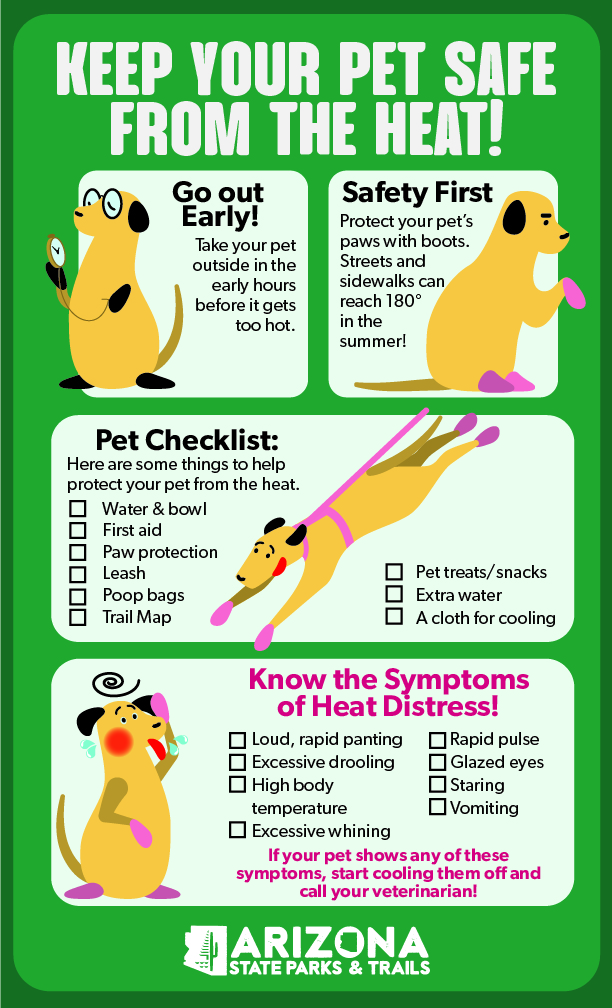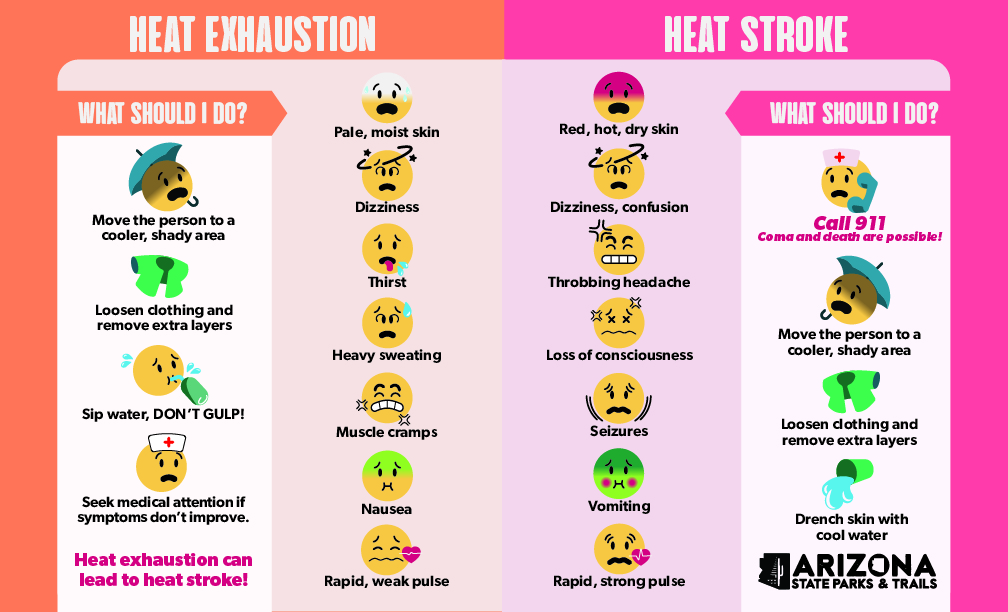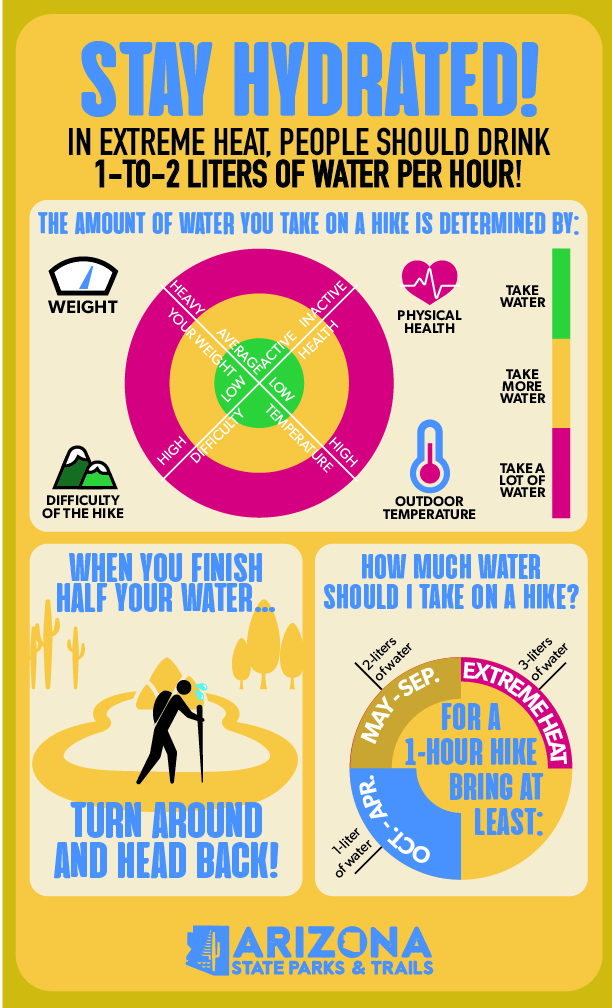
Summer Heat Safety Tips
Welcome to Arizona's breathtaking state parks, where outdoor adventures await to become unforgettable memories! Before embarking on your journey, it's crucial to prioritize safety, especially in the scorching summer heat we have here. Follow these essential tips to ensure a memorable and safe outdoor experience.
Prepare Wisely: Check the Weather and Evaluate Conditions
Before hitting the trails, always check the weather forecast. Extreme heat can pose serious risks to your health. It is important to know your limits and not take unnecessary risks. In the history of rescue operations for heat-related illnesses, not once has a victim planned on their fun outdoor adventure turning into an emergency.

Stay informed of Excessive Heat Watches and Warnings from the National Weather Service. You can also subscribe to the Arizona Department of Health Services’ Excessive Heat Warnings email alerts to receive warnings and tips on how to stay cool, stay hydrated, stay informed and be SunWise.
In temperatures exceeding 90 degrees, the Arizona Department of Health Services recommends you limit strenuous outdoor activity and time outdoors, and stay well-hydrated. In temperatures above 105, seek an indoor air-conditioned environment. See a full Heat Index Chart with health effects and safety recommendations.
In unsafe temperatures, consider rescheduling your hike for a cooler day or opting for alternative activities such as cooling down in a lake, stream, or river at Arizona’s beautiful water destinations or exploring shaded areas for picnics. You can also enjoy milder trails in the early morning hours but be sure you’re off the trail before temperatures present high risk—by 9 a.m. in summer temperatures in low elevation desert areas. Early morning easy hikes mean you’ll be rewarded with a stunning Arizona sunrise!
Remember, Arizona's diverse topography and varied elevations offer endless opportunities for year-round outdoor enjoyment. Find reprieve from the heat with trips to higher elevations in forested places like northern Arizona and the White Mountains, or the Sky Islands. If you’re looking for an extended trip outdoors, visit our summer camping resource to learn where you can go camping, how to camp in hot weather, and other summer camping hacks to stay cool during Arizona’s annual heatwave!
Hydrate, Hydrate, Hydrate
The Arizona Department of Health Services recommends drinking 2 liters of water per day (approximately 8 cups), but if you are exerting energy in the heat, that amount increases substantially to 1 to 2 liters per hour that you are outdoors. Of course, hydration needs vary by person and the amount of water you should consume in extreme heat also depends on your physical activity, age, body size, and medications. Check out our heat safety infographic below that can help you plan how much water you should bring on a hike.
Spoiler alert… if you are bringing one standard size 16 oz. bottle of water on a hike during Arizona’s summer, it’s not enough! And regardless of how much you’ve brought, remember that when you’ve finished half of your water supply, it’s time to turn around—no matter where you are on the trail.
Don’t underestimate the power of pre-hydration, which is a crucial safety measure that many overlook. By hydrating before your hike, you're giving your body a head start in combating dehydration and heat-related illnesses. Start drinking water well in advance of your outdoor adventure to ensure your body is adequately hydrated and ready for the challenges ahead.
Don't forget to replenish electrolytes with salty snacks to stay hydrated and energized throughout your journey. Bananas, granola, trail mix, and peanut butter are all great options.
Choose Your Route Wisely
When planning your hike, consider the trail conditions and terrain. Avoid trails with steep inclines and limited shade, as these can exacerbate the effects of extreme heat. Opt for shaded trails or explore higher elevations where temperatures are cooler. Remember to pace yourself and take breaks as needed to prevent overheating.

Rangers at our parks will be available to help you pick the trail that’s right for you but you can do your due diligence by viewing the park map in advance (available for each state park under the Explore menu of our park webpages). These maps depict contour lines of trails to help you understand the elevation changes you’ll encounter as well as the distance for each trail.
An average hiker can cover about 2 miles per hour in distance but this will vary depending on your physical condition, terrain difficulty, and weather conditions. Know your limits and do not underestimate the energy-zapping power of extreme heat. If you have any questions or want real-time advice about trail conditions, speak with our park rangers at the Visitor Center when you enter the park, or call ahead! Our rangers want to help you have a great outdoor experience and most importantly, stay safe.
Gear Up for Sun Protection and Emergency Preparedness
Pack essential gear to stay safe under the sun. Wear a hat, lightweight clothing with UPF protection, and apply sunscreen liberally to exposed skin. Don't forget to protect your eyes with sunglasses rated for UV protection. Consider using an umbrella for sun protection—they’re more effective than you may think!
There are best practices to follow year-round that are even more critical to follow during Arizona’s summer weather. Bring a hiking buddy and always let someone know where you’re going and about how long you’ll be gone. Bring a fully charged cell phone and if you plan to cover remote terrain where cell service may be unreliable, consider bringing a personal GPS locator device. NOTE! Electronic devices can overheat and stop working in extreme temperatures. Avoid direct sunlight on your phone, close unused apps, and you can remove the case to help it cool off faster. Make sure you can still find your way even if your phone shuts down by carrying a waterproof map or bringing a clear baggie to store the paper map in; you'll keep the map dry in the event of a summer monsoon storm or from water spills.
Don't forget to put a reflective device in your pack, like a compact mirror, in case you are lost. Signal fires shouldn't be used because they can spark a devastating wildland fire in Arizona's dry and hot conditions. Other emergency supplies to keep in your pack year-round include a headlamp, first aid kit, and heat-reflective blanket. Our rangers monitor day-use parking lots near trailheads in our parks in case a vehicle is parked for longer than expected, but your number one safety resource is you and your good planning.
Pet Safety in Extreme Heat
Our furry companions feel the heat too! Before taking your dog hiking, evaluate whether it's safe based on forecast temperatures and trail conditions. Your pet responds differently to heat than humans and cool themselves primarily through panting (did you know dogs can only sweat through their paw pads?).

Dogs easily overheat in extreme temperatures. In addition, their paws can burn on the hot ground. If it is too hot for your bare feet, it is too hot for your dog's paws. If you take your dog early in the morning before temperatures rise, consider using protective booties for their paws, and ensure they have access to shade and water at all times.
Lastly, never leave your pet in a vehicle, even for a minute. If temperatures are high, your pet will be more comfortable and safe left at home. Know the warning signs of heat distress in your pet, like loud rapid panting, excessive thirst, vomiting, and more as well as how to help them with information from the Arizona Humane Society.
Heat Exhaustion and Heat Stroke Safety Tips
Heat exhaustion and heat stroke are serious conditions that require immediate attention. Know the signs of heat-related illness with the heat exposure safety information below. Go prepared knowing how to help yourself or your neighbor in the event of an emergency.

Heat Exhaustion
If you or someone else experiences symptoms of heat exhaustion, such as heavy sweating, weakness, nausea, and headache, move to a shaded area, rest, and hydrate immediately. Remove excess clothing, loosen tight clothing, and apply cool compresses to the skin. Seek medical attention if symptoms persist or worsen. Left untreated, heat exhaustion can progress to heat stroke.
Heat Stroke
Heat stroke is a life-threatening medical emergency. If someone exhibits signs of heat stroke, such as high body temperature, confusion, rapid pulse, vomiting, or loss of consciousness, call 911 for emergency medical attention immediately. While waiting for help, move the person to a cool, shaded area, and attempt to lower their body temperature using cool water or ice/cold packs wrapped and applied to the person’s wrists, ankles, armpits and neck. Keep the person lying down and fan them with cool air. Left untreated, heat stroke can cause permanent disability or even death if emergency treatment is not given.
Final Thoughts
Stay informed, stay safe, and make the most of your outdoor adventures in Arizona's stunning landscapes. For more summer heat safety tips and helpful resources, download our heat safety brochure and visit the Arizona Department of Health Services’ Heat Safety website. You can also help spread the word with our downloadable heat safety social media graphics.
Remember, responsible outdoor recreation means prioritizing your well-being and the well-being of those around you. Embrace the beauty of Arizona's natural wonders while staying vigilant against the extreme summer heat.


